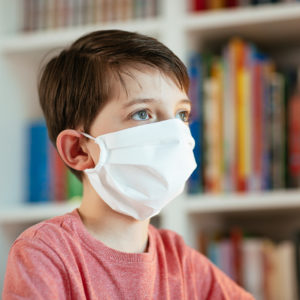Elementary school kids in masks, eating sack lunches in classrooms while cafeterias and playgrounds are closed? These are some of the recommendations from the Centers for Disease Control and Prevention (CDC) for reopening schools this fall.
“Teach and reinforce use of cloth face coverings,” the CDC’s ‘Considerations for Schools’ reads, going on to say that masks “should be worn by staff and students (particularly older students) as feasible, and are most essential in times when physical distancing is difficult.”
The agency is also recommending daily temperature checks or “symptoms checking” of staff and students if feasible, and that they be done “safely, respectfully” and “in accordance with any applicable privacy laws or regulations.”
The guidance, issued May 19, may come as a shock to school administrators, teachers and parents who believed things would be back to normal by the time their children start the new school year.
In addition to masks and temperature checks, the CDC is recommending that children bring their own lunch to school “as feasible” and that they eat lunch in their classrooms, rather than in the cafeteria. The agency is also recommending that playgrounds be closed. If not, they should be cleaned and disinfected between use by different groups of kids.
— Close communal use shared spaces such as dining halls and playgrounds with shared playground equipment if possible; otherwise, stagger use and clean and disinfect between use.
The CDC also suggests that physical barriers such as plastic screens be installed between bathroom sinks to separate children.
— Add physical barriers, such as plastic flexible screens, between bathroom sinks especially when they cannot be at least 6 feet apart.
Some of the recommendations may be next to impossible for many schools to follow, such as the recommendation that children sit one per seat and only in every other row on school buses. If school buses are more than 50 percent full, there wouldn’t be a way to have just one child on a seat that normally fits two or three.
Another dramatic change: classroom setups.
The CDC is recommending that desks in all classrooms be spaced six feet apart and that all desks be facing the same direction.
In many elementary school classrooms, desks are in clusters with children facing each other, instead of the teacher. This is in accordance with the widely held philosophy of teaching where the teacher doesn’t so much teach but acts as a “guide on the side” — a helper — while the children engage in “cooperative learning.”
So the guidelines may change not just how things look, but how learning takes place in American schools.
For students, it’s all likely to amount to a significant change. And not one they’ll be able to easily forget, as the CDC is recommending that regular announcements be broadcast over PA systems in all schools about reducing the spread of COVID-19 and is also recommending that physical signs be placed in hallways to ensure that children stay six feet apart at all times.
Students will also be reminded not to share items in the classroom, or anywhere in the school, and to remain six feet away from classmates.
— Avoid sharing electronic devices, toys, books, and other games or learning aids.
“We know how kids are,” Marion, Indiana, high school economics teacher Andy Lyons said this week, saying his students are often passing pencils and sharing paper. “What are teachers supposed to do? We’re going to be monitoring social distancing as opposed to teaching.”
Other recommendations from the CDC include staggering school drop-off and pick-up times and locations; restricting nonessential visitors — including, presumably, parent volunteers — and canceling all field trips.
The CDC says that its guidance for schools is meant to “supplement” state and local laws, not to replace them. It lists three options for re-opening schools, with the “lowest-risk” option being only virtual classes.
The “more risk” option is in-school instruction but with students staying with the same teacher all day and not mixing with other groups while classmates stay six feet apart and refrain from sharing objects.
The “highest risk” option involves in-school instruction, with no distance maintained between students and with children sharing objects freely and mixing with other groups.

